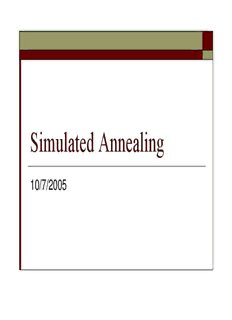
Simulated Annealing PDF
Preview Simulated Annealing
Simulated Annealing 10/7/2005 Local Search algorithms Search algorithms like breadth-first, depth-first or (cid:134) A* explore all the search space systematically by keeping one or more paths in memory and by recording which alternatives have been explored. When a goal is found, the path to that goal (cid:134) constitutes a solution. Local search algorithms can be very helpful if we are (cid:134) interested in the solution state but not in the path to that goal. They operate only on the current state and move into neighboring states . Local Search algorithms Local search algorithms have 2 key advantages: (cid:134) They use very little memory (cid:132) They can find reasonable solutions in large or infinite (cid:132) (continuous) state spaces. Some examples of local search algorithms are: (cid:134) Hill-climbing (cid:132) Random walk (cid:132) Simulated annealing (cid:132) Annealing Annealing is a thermal process for obtaining low (cid:134) energy states of a solid in a heat bath. The process contains two steps: (cid:134) Increase the temperature of the heat bath to a maximum (cid:132) value at which the solid melts. Decrease carefully the temperature of the heat bath until (cid:132) the particles arrange themselves in the ground state of the solid. Ground state is a minimum energy state of the solid. The ground state of the solid is obtained only if the (cid:134) maximum temperature is high enough and the cooling is done slowly. Simulated Annealing The process of annealing can be simulated with the (cid:134) Metropolis algorithm, which is based on Monte Carlo techniques. We can apply this algorithm to generate a solution to (cid:134) combinatorial optimization problems assuming an analogy between them and physical many-particle systems with the following equivalences: Solutions in the problem are equivalent to states in a (cid:132) physical system. The cost of a solution is equivalent to the “energy” of a (cid:132) state. Simulated Annealing To apply simulated annealing with optimization purposes we (cid:134) require the following: A successor function that returns a “close” neighboring solution given (cid:132) the actual one. This will work as the “disturbance” for the particles of the system. A target function to optimize that depends on the current state of the (cid:132) system. This function will work as the energy of the system. The search is started with a randomized state. In a polling (cid:134) loop we will move to neighboring states always accepting the moves that decrease the energy while only accepting bad moves accordingly to a probability distribution dependent on the “temperature” of the system. Simulated Annealing Decrease the temperature slowly, accepting less bad moves at (cid:134) each temperature level until at very low temperatures the algorithm becomes a greedy hill-climbing algorithm. The distribution used to (cid:134) decide if we accept a bad movement is know as Boltzman distribution. This distribution is very well known is in solid physics (cid:134) and plays a central role in simulated annealing. Where γ is the current configuration of the system, E is the γ energy related with it, and Z is a normalization constant. Simulated Annealing: the code 1. Create random initial solution γ 2. E =cost(γ); old 3. for(temp=temp ; temp>=temp ;temp=next_temp(temp) ) { max min 4. for(i=0;i<i ; i++ ) { max 5. succesor_func(γ); //this is a randomized function 6. E =cost(γ); new 7. delta=E -E new old; 8. if(delta>0) 9. if(random() >= exp(-delta/K*temp); 10. undo_func(γ); //rejected bad move 11. else 12. E =E //accepted bad move old new 13. else 14. E =E //always accept good moves old new; } } Simulated Annealing Acceptance criterion and cooling schedule (cid:134) Practical Issues with simulated annealing Cost function must be carefully developed, it has to (cid:134) be “fractal and smooth”. The energy function of the left would work with SA (cid:134) while the one of the right would fail.
Description: